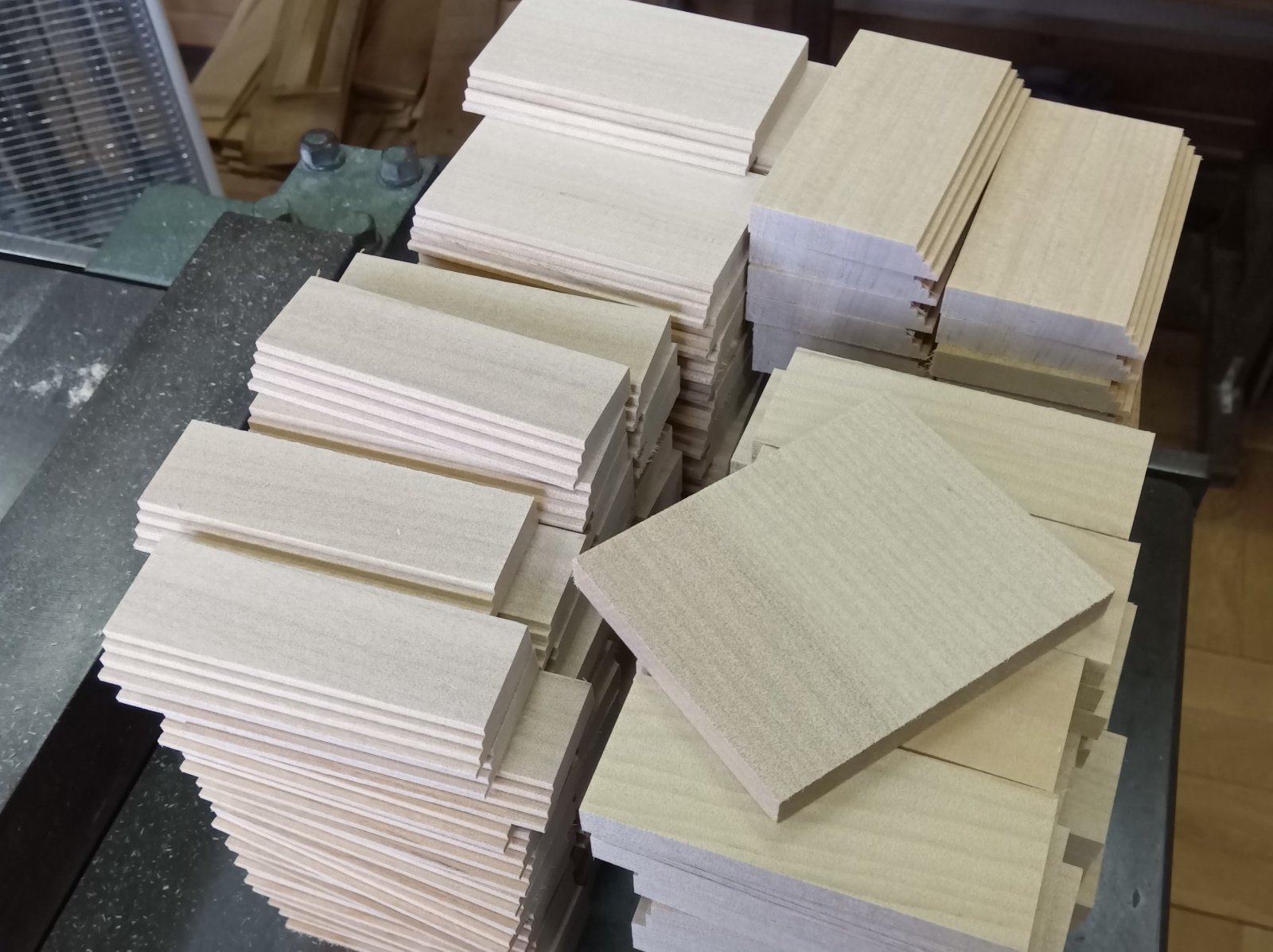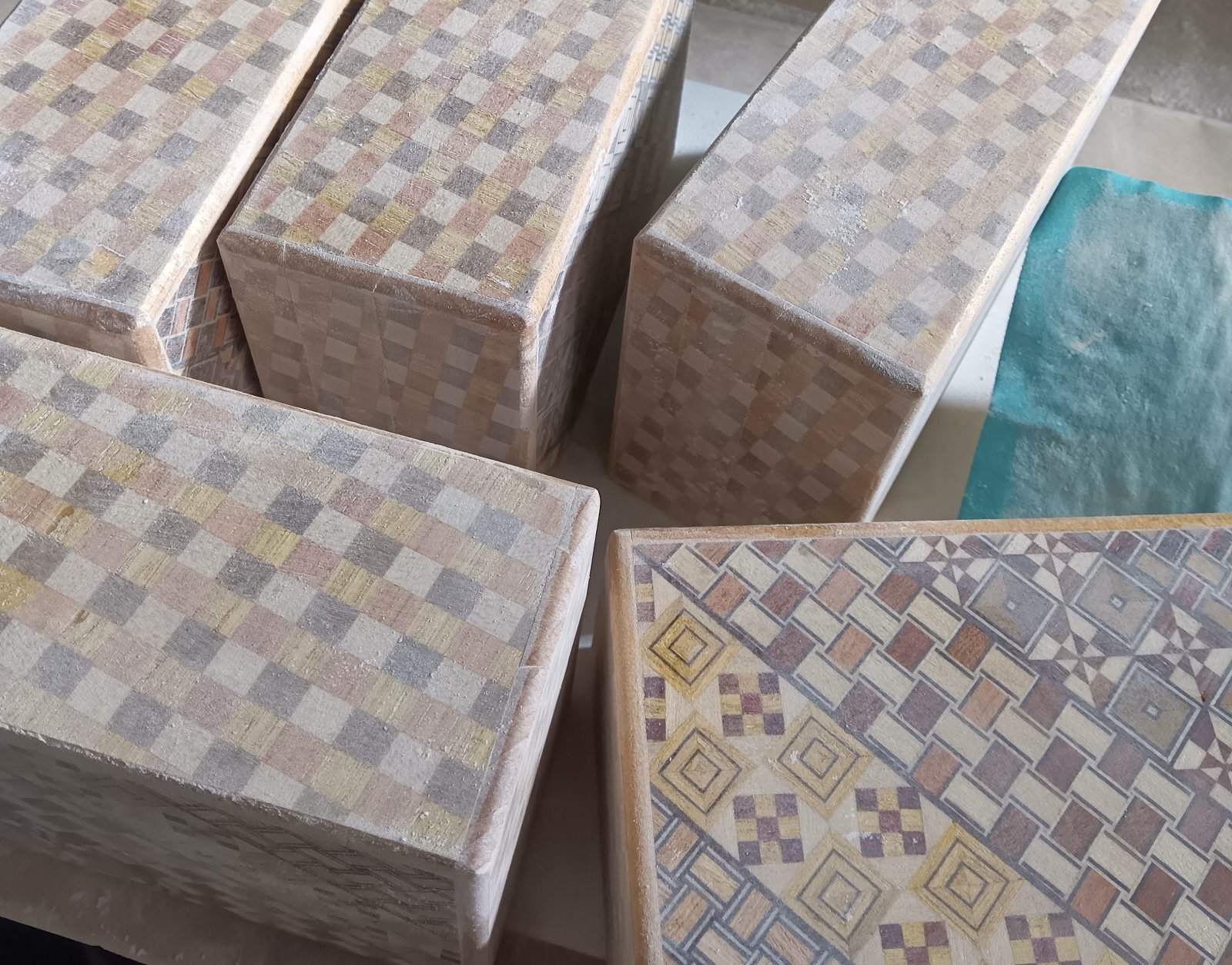27-step Aruki panels
Today, I worked on the Aruki (moving panels) production of the 5-sun 27-step puzzle box while also doing the finishing coat for the 4-sun box in parallel. As I mentioned yesterday, a strong cold wave has arrived in our region, and we are experiencing very cold days. Because of this, I prefer to do the painting work in the afternoon when it feels a little less cold 😅
In the morning, I completed about half of the Aruki production, and I worked on the remaining process in the afternoon. The Aruki production for the 27-step puzzle box requires quite some time. Therefore, instead of making it all in one day, I have recently adopted the approach of progressing little by little on different days. Specifically, the Aruki has a detailed step-shaped design, which takes time to process. To manage this, I complete this step on a separate day in advance. This step-shaped processing is applied to all Aruki panels, meaning two side panels and two top and bottom panels. For example, if I am making 30 boxes, I need to process 120 sections in total. Each step-shaped cut consists of four layers, and since each panel requires three cuts, it results in 360 cuts in total. This is an extremely demanding task, so I process four panels at a time, reducing the number of cuts by a quarter to 90 cuts. Even so, it still requires a significant amount of time, so I usually conclude the Aruki production process for the day after completing this step.
In the afternoon, I worked on the finishing coat process for the 4-sun boxes. First, I polished the boxes that were primed yesterday. Since the surface is rough, I carefully sanded it down with fine sandpaper to create a smooth finish. This is a very delicate process because I need to flatten the surface while ensuring that the primer applied yesterday remains on the box. The key is to stop sanding at just the right point. After that, I sprayed the topcoat onto the surface. This two-layer coating process creates a stronger protective film, enhancing the durability of the box. Today's work has been successfully completed. I will leave the boxes to dry until tomorrow. In reality, they become dry enough to handle in about two hours, but I wait until the next day before opening the mechanism.
There are several workshops in this region that specialize solely in painting of wooden works. Normally, wood product manufacturers like us make the boxes and then outsource the painting to these specialists. Compared to them, my painting skills are still at a lower level. However, the reason I am able to do this kind of painting is that I learned and practiced electric guitar finishing a long time ago. I use the same techniques I learned back then. Electric guitar finishes are very thick, with multiple layers of coating, giving the surface a plastic-like appearance. In contrast, our boxes are coated only two or three times at most. Still, I apply the techniques I learned from guitar finishing to our process.
Have a good weekend!😄
In the morning, I completed about half of the Aruki production, and I worked on the remaining process in the afternoon. The Aruki production for the 27-step puzzle box requires quite some time. Therefore, instead of making it all in one day, I have recently adopted the approach of progressing little by little on different days. Specifically, the Aruki has a detailed step-shaped design, which takes time to process. To manage this, I complete this step on a separate day in advance. This step-shaped processing is applied to all Aruki panels, meaning two side panels and two top and bottom panels. For example, if I am making 30 boxes, I need to process 120 sections in total. Each step-shaped cut consists of four layers, and since each panel requires three cuts, it results in 360 cuts in total. This is an extremely demanding task, so I process four panels at a time, reducing the number of cuts by a quarter to 90 cuts. Even so, it still requires a significant amount of time, so I usually conclude the Aruki production process for the day after completing this step.
In the afternoon, I worked on the finishing coat process for the 4-sun boxes. First, I polished the boxes that were primed yesterday. Since the surface is rough, I carefully sanded it down with fine sandpaper to create a smooth finish. This is a very delicate process because I need to flatten the surface while ensuring that the primer applied yesterday remains on the box. The key is to stop sanding at just the right point. After that, I sprayed the topcoat onto the surface. This two-layer coating process creates a stronger protective film, enhancing the durability of the box. Today's work has been successfully completed. I will leave the boxes to dry until tomorrow. In reality, they become dry enough to handle in about two hours, but I wait until the next day before opening the mechanism.
There are several workshops in this region that specialize solely in painting of wooden works. Normally, wood product manufacturers like us make the boxes and then outsource the painting to these specialists. Compared to them, my painting skills are still at a lower level. However, the reason I am able to do this kind of painting is that I learned and practiced electric guitar finishing a long time ago. I use the same techniques I learned back then. Electric guitar finishes are very thick, with multiple layers of coating, giving the surface a plastic-like appearance. In contrast, our boxes are coated only two or three times at most. Still, I apply the techniques I learned from guitar finishing to our process.
Have a good weekend!😄

